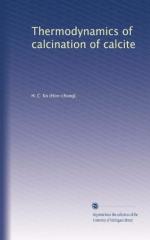|
This section contains 228 words (approx. 1 page at 300 words per page) |
In calcination, a substance is heated to a high temperature below its melting point to bring about thermal decomposition or a phase transition other than melting. Calcination often has the effect of making a substance friable. The process usually takes place in long cylindrical kilns. Calcined materials may lose water (as in the conversion of ferric hydroxide to ferric oxide) or some other volatile constituent (such as carbon dioxide upon heating limestone), or may undergo oxidation or reduction. In oxidative calcination (also known as roasting), a substance is heated in the presence of air or oxygen. Oxidative calcination is commonly used to convert metal sulfide ores to oxides in the first step of recovering such metals as zinc, lead, and copper. Reductive calcination (smelting) involves the heating and reduction of metals from their ores, followed by separation out of the valueless material.
Calcination reactions may include thermal dissociation, including the destructive distillation of organic compounds, i.e., heating a highly carbonaceous material in the absence of air or oxygen, to produce solids, liquids, and gases). Examples of other calcination reactions include the concentration of aluminum by heating bauxite; polymorphic phase transitions such as the conversion of anatase to the rutile; and thermal recrystallizations such as the devitrification of glass. Materials that are commonly calcined include phosphate, aluminum oxide, manganese carbonate, petrol coke, and sea water magnesite.
|
This section contains 228 words (approx. 1 page at 300 words per page) |


